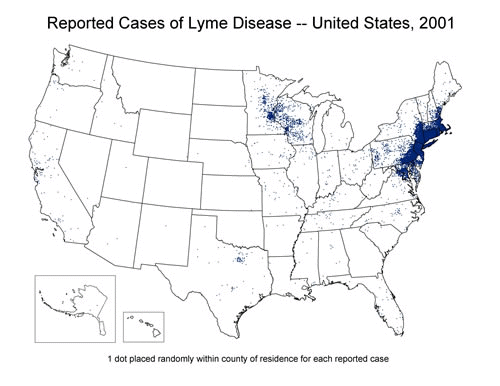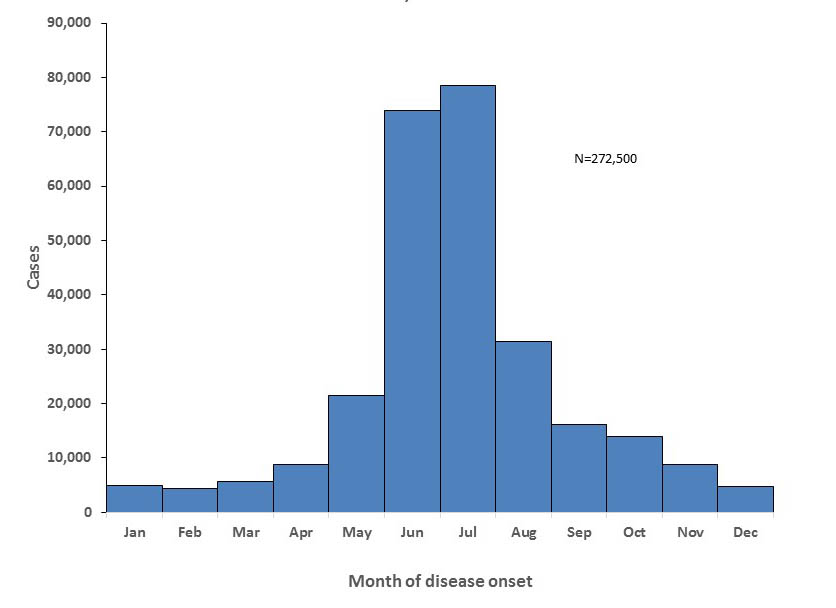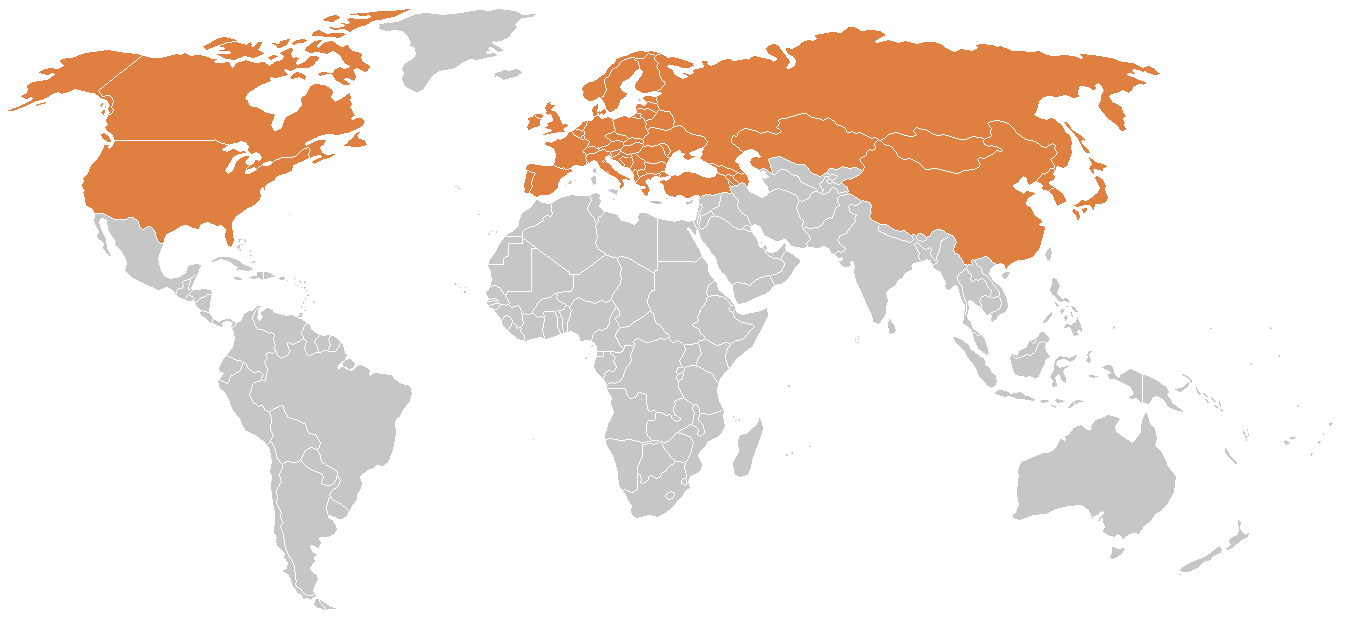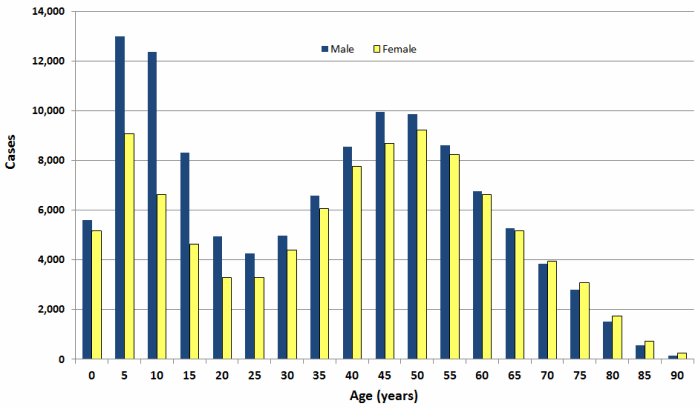Lyme disease epidemiology and demographics: Difference between revisions
m (Bot: Removing from Primary care) |
|||
| (20 intermediate revisions by 6 users not shown) | |||
| Line 1: | Line 1: | ||
__NOTOC__ | __NOTOC__ | ||
{{Lyme disease}} | {{Lyme disease}} | ||
{{CMG}} {{AE}} {{IMD}} | {{CMG}};{{AE}} {{Anmol}}, {{IMD}} | ||
==Overview== | ==Overview== | ||
Lyme disease is the most | [[Lyme disease]] is the most commonly reported vector-borne illness in the United States. In 2015, it was the sixth most common [[notifiable disease|nationally notifiable disease]]. The number of people diagnosed with [[Lyme disease]] each year in the United States is around 30,000. This disease is concentrated heavily in the Northeast and upper Midwest. [[Lyme disease]] has a seasonal variation and incidence increases during months of May to August. | ||
==Epidemiology and Demographics== | ==Epidemiology and Demographics== | ||
===Incidence=== | ===Incidence=== | ||
*Lyme disease is the most common [[tick-borne disease]] in North America and Europe, and one of the fastest-growing [[infectious diseases]] in the United States. | *Lyme disease is the most common [[tick-borne disease]] in North America and Europe, and one of the fastest-growing [[infectious diseases]] in the United States. | ||
* | *The number of people diagnosed with [[Lyme disease]] each year in the United States is around 30,000.<ref name="urlLyme disease data tables | Lyme Disease | CDC">{{cite web |url=https://www.cdc.gov/lyme/stats/tables.html |title=Lyme disease data tables | Lyme Disease | CDC |format= |work= |accessdate=}}</ref> | ||
*In the | * In the United States, the [[incidence]] of [[Lyme disease]] is 8.1 per 100,000 individuals as per data collected by the [[Center for Disease Control]] ([[CDC]]) in 2016.<ref name="urlData and Statistics | Lyme Disease | CDC2">{{cite web |url=https://www.cdc.gov/lyme/stats/index.html |title=Data and Statistics | Lyme Disease | CDC |format= |work= |accessdate=}}</ref> | ||
*Although Lyme disease has now been reported in | *In the fourteen states where [[Lyme disease]] is most common, the average was 40.4 cases for every 100,000 persons in the year 2015.<ref name="urlLyme disease data tables | Lyme Disease | CDC" /><ref name="urlData and Statistics | Lyme Disease | CDC">{{cite web |url=https://www.cdc.gov/lyme/stats/index.html |title=Data and Statistics | Lyme Disease | CDC |format= |work= |accessdate=}}</ref> | ||
[[Image: | *Although [[Lyme disease]] has now been reported in the majority of states in the U.S, about 95% of all reported cases are confined to just five geographic areas including New England, Mid-Atlantic, East-North Central, South Atlantic, and West North-Central.<ref name="urlData and Statistics | Lyme Disease | CDC" /> | ||
[[Image:Reported cases of lyme disease in usa from 2001-2015.gif|center|750px|frame|Reported cases of Lyme disease in the United Stated from 2001 to 2015 - [https://www.cdc.gov/lyme/stats/maps.html Source: CDC.gov]]] | |||
=== Seasonal Variation === | |||
*The [[prevalence]] of [[infection]] in adult [[ticks]] is more than nymph stage ticks in [[pathogens]] [[infectious]] to humans, but the majority of [[infections]] are caused by [[ticks]] in the nymph stage during the late spring and summer.<ref name="SchwartzFish1997">{{cite journal|last1=Schwartz|first1=Ira|last2=Fish|first2=Durland|last3=Daniels|first3=Thomas J.|title=Prevalence of the Rickettsial Agent of Human Granulocytic Ehrlichiosis in Ticks from a Hyperendemic Focus of Lyme Disease|journal=New England Journal of Medicine|volume=337|issue=1|year=1997|pages=49–50|issn=0028-4793|doi=10.1056/NEJM199707033370111}}</ref><ref name="pmid10206627">{{cite journal| author=Falco RC, McKenna DF, Daniels TJ, Nadelman RB, Nowakowski J, Fish D et al.| title=Temporal relation between Ixodes scapularis abundance and risk for Lyme disease associated with erythema migrans. | journal=Am J Epidemiol | year= 1999 | volume= 149 | issue= 8 | pages= 771-6 | pmid=10206627 | doi= | pmc= | url=https://www.ncbi.nlm.nih.gov/entrez/eutils/elink.fcgi?dbfrom=pubmed&tool=sumsearch.org/cite&retmode=ref&cmd=prlinks&id=10206627 }}</ref> | |||
*This is the reason for an increase in the [[incidence]] of [[Lyme disease]] during the months of May to August. | |||
[[image:Seasonal variation of lyme disease.jpg|center|500px|thumb|Confirmed Lyme disease cases by month of disease onset–United States, 2001-2015 - [https://www.cdc.gov/lyme/stats/graphs.html Source: CDC.gov]]] | |||
===Widespread disease and endemic regions=== | ===Widespread disease and endemic regions=== | ||
*The number of reported cases of the disease | *The number of reported cases of [[Disease|the disease]] has been increasing, as is the number of [[Endemic (epidemiology)|endemic]] regions in North America. | ||
*''B. burgdorferi'' sensu lato has been maintained in enzootic cycles in California as well as other regions throughout North America, Europe and North Africa. Indeed, the [[DNA]] of ''Borrelia'' has been detected in lizards, indicating that they can be infected.<ref>{{cite journal |author=Swanson KI, Norris DE |title=Detection of Borrelia burgdorferi DNA in lizards from Southern Maryland |journal=Vector Borne Zoonotic Dis. |volume=7 |issue=1 |pages=42-9 |year=2007 |pmid=17417956 |doi=10.1089/vbz.2006.0548}}</ref> | *''[[Borrelia burgdorferi|B. burgdorferi]]'' sensu lato has been maintained in enzootic cycles in California as well as other regions throughout North America, Europe, and North Africa. Indeed, the [[DNA]] of ''[[Borrelia]]'' has been detected in lizards, indicating that they can be [[Infection (disambiguation)|infected]].<ref>{{cite journal |author=Swanson KI, Norris DE |title=Detection of Borrelia burgdorferi DNA in lizards from Southern Maryland |journal=Vector Borne Zoonotic Dis. |volume=7 |issue=1 |pages=42-9 |year=2007 |pmid=17417956 |doi=10.1089/vbz.2006.0548}}</ref> | ||
*In Europe, cases of ''B. burgdorferi'' sensu lato infected ticks are found predominantly in Norway, Netherlands, Germany, France, Italy, Slovenia and Poland, but have been isolated in almost every country on the continent. Lyme disease statistics for Europe can be found at [http://www.eurosurveillance.org/ew/2006/060622.asp Eurosurveillance website]. | *In Europe, cases of ''[[Borrelia burgdorferi|B. burgdorferi]]'' sensu lato [[infected]] [[Tick|ticks]] are found predominantly in Norway, Netherlands, Germany, France, Italy, Slovenia, and Poland, but have been isolated in almost every country on the continent. [[Lyme disease]] statistics for Europe can be found at the [http://www.eurosurveillance.org/ew/2006/060622.asp Eurosurveillance website]. | ||
*''B. burgdorferi'' sensu lato infested ticks are being found more frequently in Japan, as well as in northwest China and far eastern Russia.<ref>{{cite journal |author=Li M, Masuzawa T, Takada N, ''et al'' |title=Lyme disease Borrelia species in northeastern China resemble those isolated from far eastern Russia and Japan |journal=Appl. Environ. Microbiol. |volume=64 |issue=7 |pages=2705-9 |year=1998 |pmid=9647853 |url=http://aem.asm.org/cgi/content/full/64/7/2705?view=long&pmid=9647853}}</ref><ref>{{cite journal |author=Masuzawa T |title=Terrestrial distribution of the Lyme borreliosis agent Borrelia burgdorferi sensu lato in East Asia |journal=Jpn. J. Infect. Dis. |volume=57 |issue=6 |pages=229-35 |year=2004 |pmid=15623946 |url = http://www.nih.go.jp/JJID/57/229.html}}</ref> ''Borrelia'' has been isolated in Mongolia as well.<ref>{{cite journal |author=Walder G, Lkhamsuren E, Shagdar A, ''et al'' |title=Serological evidence for tick-borne encephalitis, borreliosis, and human granulocytic anaplasmosis in Mongolia |journal=Int. J. Med. Microbiol. |volume=296 Suppl 40 |issue= |pages=69-75 |year=2006 |pmid=16524782 |doi=10.1016/j.ijmm.2006.01.031}}</ref> | *''[[Borrelia burgdorferi|B. burgdorferi]]'' sensu lato infested [[Tick|ticks]] are being found more frequently in Japan, as well as in northwest China and far eastern Russia.<ref>{{cite journal |author=Li M, Masuzawa T, Takada N, ''et al'' |title=Lyme disease Borrelia species in northeastern China resemble those isolated from far eastern Russia and Japan |journal=Appl. Environ. Microbiol. |volume=64 |issue=7 |pages=2705-9 |year=1998 |pmid=9647853 |url=http://aem.asm.org/cgi/content/full/64/7/2705?view=long&pmid=9647853}}</ref><ref>{{cite journal |author=Masuzawa T |title=Terrestrial distribution of the Lyme borreliosis agent Borrelia burgdorferi sensu lato in East Asia |journal=Jpn. J. Infect. Dis. |volume=57 |issue=6 |pages=229-35 |year=2004 |pmid=15623946 |url = http://www.nih.go.jp/JJID/57/229.html}}</ref> ''[[Borrelia]]'' has been isolated in Mongolia as well.<ref>{{cite journal |author=Walder G, Lkhamsuren E, Shagdar A, ''et al'' |title=Serological evidence for tick-borne encephalitis, borreliosis, and human granulocytic anaplasmosis in Mongolia |journal=Int. J. Med. Microbiol. |volume=296 Suppl 40 |issue= |pages=69-75 |year=2006 |pmid=16524782 |doi=10.1016/j.ijmm.2006.01.031}}</ref> | ||
*In South America tick-borne disease recognition and occurrence is rising. | *In South America, [[tick-borne disease]] recognition and occurrence is rising. | ||
*Ticks carrying ''B. burgdorferi'' sensu lato, as well as canine and human tick-borne disease, have been reported widely in Brazil, but the subspecies of ''Borrelia'' | *[[Tick|Ticks]] carrying ''[[Borrelia burgdorferi|B. burgdorferi]]'' sensu lato, as well as canine and human [[tick-borne disease]], have been reported widely in Brazil, but the subspecies of ''Borrelia'' have not yet been defined.<ref>{{cite journal |author=Mantovani E, Costa IP, Gauditano G, Bonoldi VL, Higuchi ML, Yoshinari NH |title=Description of Lyme disease-like syndrome in Brazil. Is it a new tick borne disease or Lyme disease variation? |journal=Braz. J. Med. Biol. Res. |volume=40 |issue=4 |pages=443-56 |year=2007 |pmid=17401487 }}</ref> The first reported case of [[Lyme disease]] in Brazil was in 1993 in Sao Paulo.<ref>{{cite journal |author=Yoshinari NH, Oyafuso LK, Monteiro FG, ''et al'' |title=Lyme disease. Report of a case observed in Brazil |language=Portuguese |journal=Revista do Hospital das Clínicas |volume=48 |issue=4 |pages=170-4 |year=1993 |pmid=8284588 }}</ref> | ||
*In Northern Africa ''B. burgdorferi'' sensu lato has been identified in Morocco, Algeria, Egypt and Tunisia.<ref>{{cite journal |author=Bouattour A, Ghorbel A, Chabchoub A, Postic D |title=Lyme borreliosis situation in North Africa |language=French |journal=Archives de l'Institut Pasteur de Tunis |volume=81 |issue=1-4 |pages=13-20 |year=2004 |pmid=16929760 }}</ref><ref>{{cite journal |author=Dsouli N, Younsi-Kabachii H, Postic D, ''et al'' |title=Reservoir role of lizard Psammodromus algirus in transmission cycle of Borrelia burgdorferi sensu lato (Spirochaetaceae) in Tunisia |journal=J. Med. Entomol. |volume=43 |issue=4 |pages=737-42 |year=2006 |pmid=16892633 }}</ref><ref>{{cite journal |author=Helmy N |title=Seasonal abundance of Ornithodoros (O.) savignyi and prevalence of infection with Borrelia spirochetes in Egypt |journal=Journal of the Egyptian Society of Parasitology |volume=30 |issue=2 |pages=607-19 |year=2000 |pmid=10946521}}</ref> | *''[[Borrelia burgdorferi|B. burgdorferi]]'' sensu stricto [[antigens]] in patients have been identified in Colombia and Bolivia. | ||
*In Western and sub-Saharan Africa, tick-borne [[relapsing fever]] was first identified by the British physicians Joseph Dutton and John Todd in 1905. | *In Northern Africa, ''[[Borrelia burgdorferi|B. burgdorferi]]'' sensu lato has been identified in Morocco, Algeria, Egypt, and Tunisia.<ref>{{cite journal |author=Bouattour A, Ghorbel A, Chabchoub A, Postic D |title=Lyme borreliosis situation in North Africa |language=French |journal=Archives de l'Institut Pasteur de Tunis |volume=81 |issue=1-4 |pages=13-20 |year=2004 |pmid=16929760 }}</ref><ref>{{cite journal |author=Dsouli N, Younsi-Kabachii H, Postic D, ''et al'' |title=Reservoir role of lizard Psammodromus algirus in transmission cycle of Borrelia burgdorferi sensu lato (Spirochaetaceae) in Tunisia |journal=J. Med. Entomol. |volume=43 |issue=4 |pages=737-42 |year=2006 |pmid=16892633 }}</ref><ref>{{cite journal |author=Helmy N |title=Seasonal abundance of Ornithodoros (O.) savignyi and prevalence of infection with Borrelia spirochetes in Egypt |journal=Journal of the Egyptian Society of Parasitology |volume=30 |issue=2 |pages=607-19 |year=2000 |pmid=10946521}}</ref> | ||
*In Western and sub-Saharan Africa, tick-borne [[relapsing fever]] was first identified by the British physicians Joseph Dutton and John Todd in 1905. ''[[Borrelia]]'' in the manifestation of [[Lyme disease]] in this region is presently unknown but evidence indicates that Lyme disease may occur in humans in sub-Saharan Africa. The abundance of hosts and [[tick]] [[Vector|vectors]] would favor the establishment of [[Lyme]] [[infection]] in Africa.<ref>{{cite journal |author=Fivaz BH, Petney TN |title=Lyme disease--a new disease in southern Africa? |journal=Journal of the South African Veterinary Association |volume=60 |issue=3 |pages=155-8 |year=1989 |pmid=2699499}}</ref> In East Africa, two cases of [[Lyme disease]] have been reported in Kenya.<ref>{{cite journal |author=Jowi JO, Gathua SN |title=Lyme disease: report of two cases |journal=East African medical journal |volume=82 |issue=5 |pages=267-9 |year=2005 |pmid=16119758}}</ref> | |||
*In Australia there is no definitive evidence for the existence of ''B. burgdorferi'' or for any other tick-borne spirochete that may be responsible for a local syndrome being reported as Lyme disease.<ref>{{cite journal |author=Piesman J, Stone BF |title=Vector competence of the Australian paralysis tick, Ixodes holocyclus, for the Lyme disease spirochete Borrelia burgdorferi |journal=Int. J. Parasitol. |volume=21 |issue=1 |pages=109-11 |year=1991 |pmid=2040556}}</ref> | *In Australia there is no definitive evidence for the existence of ''[[Borrelia burgdorferi|B. burgdorferi]]'' or for any other [[Tick-borne disease|tick-borne]] [[Spirochaete|spirochete]] that may be responsible for a local syndrome being reported as [[Lyme disease]].<ref>{{cite journal |author=Piesman J, Stone BF |title=Vector competence of the Australian paralysis tick, Ixodes holocyclus, for the Lyme disease spirochete Borrelia burgdorferi |journal=Int. J. Parasitol. |volume=21 |issue=1 |pages=109-11 |year=1991 |pmid=2040556}}</ref> Cases of neuroborreliosis have been documented in Australia but are often ascribed to travel to other continents. The existence of [[Lyme disease]] in Australia is controversial. | ||
*Data shows that Northern hemisphere temperate regions are most [[Endemic (epidemiology)|endemic]] for [[Lyme disease|Lyme diseas]]<nowiki/>e.<ref>{{cite journal |author=Grubhoffer L, Golovchenko M, Vancová M, Zacharovová-Slavícková K, Rudenko N, Oliver JH |title=Lyme borreliosis: insights into tick-/host-borrelia relations |journal=Folia Parasitol. |volume=52 |issue=4 |pages=279-94 |year=2005 |pmid=16405291}}</ref><ref>{{cite journal |author=Higgins R |title=Emerging or re-emerging bacterial zoonotic diseases: bartonellosis, leptospirosis, Lyme borreliosis, plague |journal=Rev. - Off. Int. Epizoot. |volume=23 |issue=2 |pages=569-81 |year=2004 |pmid=15702720}}</ref> | |||
*Data shows that Northern hemisphere temperate regions are most endemic for Lyme disease.<ref>{{cite journal |author=Grubhoffer L, Golovchenko M, Vancová M, Zacharovová-Slavícková K, Rudenko N, Oliver JH |title=Lyme borreliosis: insights into tick-/host-borrelia relations |journal=Folia Parasitol. |volume=52 |issue=4 |pages=279-94 |year=2005 |pmid=16405291}}</ref><ref>{{cite journal |author=Higgins R |title=Emerging or re-emerging bacterial zoonotic diseases: bartonellosis, leptospirosis, Lyme borreliosis, plague |journal=Rev. - Off. Int. Epizoot. |volume=23 |issue=2 |pages=569-81 |year=2004 |pmid=15702720}}</ref> | |||
[[Image:Geographical distribution of reported Lyme Disease cases.png|centre|650px|Geographical distribution of Lyme disease.]] | [[Image:Geographical distribution of reported Lyme Disease cases.png|centre|650px|thumb| Geographical distribution of Lyme disease - [https://commons.wikimedia.org/wiki/File:Geographical_distribution_of_reported_Lyme_Disease_cases.png Source: WIKICOMMONS]]] | ||
<br clear="left" /> | <br clear="left" /> | ||
===Age | ===Age=== | ||
*There's a higher incidence of infection among children and infants of less than a year to 15 years. | *There's a higher [[incidence]] of [[infection]] among children and infants of less than a year to 15 years. | ||
*Another peak occurs in individuals between the ages of 40 to 55 years. | *Another peak occurs in individuals between the ages of 40 to 55 years. | ||
*On average, there is a higher incidence among males than females. However among | |||
[[Image:Agesex lyme.gif|center| | ===Gender=== | ||
*On average, there is a higher incidence among males than females. | |||
*However, among people aged 70 and higher, females tend to have a higher incidence of infection. | |||
[[Image:Agesex lyme.gif|center|500px|thumb|Peaks occur in males between the ages of less than one year to 15 and 40 to 55 years. Female patients are at a slightly higher risk than male patients above the age of 70. - [https://www.cdc.gov/lyme/stats/graphs.html Source: CDC.gov]]] | |||
===Race=== | |||
*[[Lyme disease]] is more prevalent in the Caucasian population.<ref name="urlRacial Disparities in Nationally Notifiable Diseases --- United States, 2002">{{cite web |url=https://www.cdc.gov/mmwr/preview/mmwrhtml/mm5401a4.htm |title=Racial Disparities in Nationally Notifiable Diseases --- United States, 2002 |format= |work= |accessdate=}}</ref> | |||
==References== | ==References== | ||
{{Reflist|2}} | {{Reflist|2}} | ||
{{WikiDoc Help Menu}} | |||
{{WikiDoc Sources}} | |||
[[Category:Bacterial diseases]] | [[Category:Bacterial diseases]] | ||
| Line 47: | Line 62: | ||
[[Category:Spirochaetes]] | [[Category:Spirochaetes]] | ||
[[Category:Disease]] | [[Category:Disease]] | ||
[[Category:Dermatology]] | [[Category:Dermatology]] | ||
[[Category:Emergency medicine]] | [[Category:Emergency medicine]] | ||
[[Category:Intensive care medicine]] | [[Category:Intensive care medicine]] | ||
[[Category:Up-To-Date]] | |||
[[Category:Infectious disease]] | |||
[[Category:Ophthalmology]] | |||
[[Category:Neurology]] | |||
[[Category:Cardiology]] | |||
[[Category:Rheumatology]] | |||
Latest revision as of 22:35, 29 July 2020
|
Lyme disease Microchapters |
|
Diagnosis |
|---|
|
Treatment |
|
Case Studies |
|
Lyme disease epidemiology and demographics On the Web |
|
American Roentgen Ray Society Images of Lyme disease epidemiology and demographics |
|
Risk calculators and risk factors for Lyme disease epidemiology and demographics |
Editor-In-Chief: C. Michael Gibson, M.S., M.D. [1];Associate Editor(s)-in-Chief: Anmol Pitliya, M.B.B.S. M.D.[2], Ilan Dock, B.S.
Overview
Lyme disease is the most commonly reported vector-borne illness in the United States. In 2015, it was the sixth most common nationally notifiable disease. The number of people diagnosed with Lyme disease each year in the United States is around 30,000. This disease is concentrated heavily in the Northeast and upper Midwest. Lyme disease has a seasonal variation and incidence increases during months of May to August.
Epidemiology and Demographics
Incidence
- Lyme disease is the most common tick-borne disease in North America and Europe, and one of the fastest-growing infectious diseases in the United States.
- The number of people diagnosed with Lyme disease each year in the United States is around 30,000.[1]
- In the United States, the incidence of Lyme disease is 8.1 per 100,000 individuals as per data collected by the Center for Disease Control (CDC) in 2016.[2]
- In the fourteen states where Lyme disease is most common, the average was 40.4 cases for every 100,000 persons in the year 2015.[1][3]
- Although Lyme disease has now been reported in the majority of states in the U.S, about 95% of all reported cases are confined to just five geographic areas including New England, Mid-Atlantic, East-North Central, South Atlantic, and West North-Central.[3]

Seasonal Variation
- The prevalence of infection in adult ticks is more than nymph stage ticks in pathogens infectious to humans, but the majority of infections are caused by ticks in the nymph stage during the late spring and summer.[4][5]
- This is the reason for an increase in the incidence of Lyme disease during the months of May to August.

Widespread disease and endemic regions
- The number of reported cases of the disease has been increasing, as is the number of endemic regions in North America.
- B. burgdorferi sensu lato has been maintained in enzootic cycles in California as well as other regions throughout North America, Europe, and North Africa. Indeed, the DNA of Borrelia has been detected in lizards, indicating that they can be infected.[6]
- In Europe, cases of B. burgdorferi sensu lato infected ticks are found predominantly in Norway, Netherlands, Germany, France, Italy, Slovenia, and Poland, but have been isolated in almost every country on the continent. Lyme disease statistics for Europe can be found at the Eurosurveillance website.
- B. burgdorferi sensu lato infested ticks are being found more frequently in Japan, as well as in northwest China and far eastern Russia.[7][8] Borrelia has been isolated in Mongolia as well.[9]
- In South America, tick-borne disease recognition and occurrence is rising.
- Ticks carrying B. burgdorferi sensu lato, as well as canine and human tick-borne disease, have been reported widely in Brazil, but the subspecies of Borrelia have not yet been defined.[10] The first reported case of Lyme disease in Brazil was in 1993 in Sao Paulo.[11]
- B. burgdorferi sensu stricto antigens in patients have been identified in Colombia and Bolivia.
- In Northern Africa, B. burgdorferi sensu lato has been identified in Morocco, Algeria, Egypt, and Tunisia.[12][13][14]
- In Western and sub-Saharan Africa, tick-borne relapsing fever was first identified by the British physicians Joseph Dutton and John Todd in 1905. Borrelia in the manifestation of Lyme disease in this region is presently unknown but evidence indicates that Lyme disease may occur in humans in sub-Saharan Africa. The abundance of hosts and tick vectors would favor the establishment of Lyme infection in Africa.[15] In East Africa, two cases of Lyme disease have been reported in Kenya.[16]
- In Australia there is no definitive evidence for the existence of B. burgdorferi or for any other tick-borne spirochete that may be responsible for a local syndrome being reported as Lyme disease.[17] Cases of neuroborreliosis have been documented in Australia but are often ascribed to travel to other continents. The existence of Lyme disease in Australia is controversial.
- Data shows that Northern hemisphere temperate regions are most endemic for Lyme disease.[18][19]

Age
- There's a higher incidence of infection among children and infants of less than a year to 15 years.
- Another peak occurs in individuals between the ages of 40 to 55 years.
Gender
- On average, there is a higher incidence among males than females.
- However, among people aged 70 and higher, females tend to have a higher incidence of infection.

Race
- Lyme disease is more prevalent in the Caucasian population.[20]
References
- ↑ 1.0 1.1 "Lyme disease data tables | Lyme Disease | CDC".
- ↑ "Data and Statistics | Lyme Disease | CDC".
- ↑ 3.0 3.1 "Data and Statistics | Lyme Disease | CDC".
- ↑ Schwartz, Ira; Fish, Durland; Daniels, Thomas J. (1997). "Prevalence of the Rickettsial Agent of Human Granulocytic Ehrlichiosis in Ticks from a Hyperendemic Focus of Lyme Disease". New England Journal of Medicine. 337 (1): 49–50. doi:10.1056/NEJM199707033370111. ISSN 0028-4793.
- ↑ Falco RC, McKenna DF, Daniels TJ, Nadelman RB, Nowakowski J, Fish D; et al. (1999). "Temporal relation between Ixodes scapularis abundance and risk for Lyme disease associated with erythema migrans". Am J Epidemiol. 149 (8): 771–6. PMID 10206627.
- ↑ Swanson KI, Norris DE (2007). "Detection of Borrelia burgdorferi DNA in lizards from Southern Maryland". Vector Borne Zoonotic Dis. 7 (1): 42–9. doi:10.1089/vbz.2006.0548. PMID 17417956.
- ↑ Li M, Masuzawa T, Takada N; et al. (1998). "Lyme disease Borrelia species in northeastern China resemble those isolated from far eastern Russia and Japan". Appl. Environ. Microbiol. 64 (7): 2705–9. PMID 9647853.
- ↑ Masuzawa T (2004). "Terrestrial distribution of the Lyme borreliosis agent Borrelia burgdorferi sensu lato in East Asia". Jpn. J. Infect. Dis. 57 (6): 229–35. PMID 15623946.
- ↑ Walder G, Lkhamsuren E, Shagdar A; et al. (2006). "Serological evidence for tick-borne encephalitis, borreliosis, and human granulocytic anaplasmosis in Mongolia". Int. J. Med. Microbiol. 296 Suppl 40: 69–75. doi:10.1016/j.ijmm.2006.01.031. PMID 16524782.
- ↑ Mantovani E, Costa IP, Gauditano G, Bonoldi VL, Higuchi ML, Yoshinari NH (2007). "Description of Lyme disease-like syndrome in Brazil. Is it a new tick borne disease or Lyme disease variation?". Braz. J. Med. Biol. Res. 40 (4): 443–56. PMID 17401487.
- ↑ Yoshinari NH, Oyafuso LK, Monteiro FG; et al. (1993). "Lyme disease. Report of a case observed in Brazil". Revista do Hospital das Clínicas (in Portuguese). 48 (4): 170–4. PMID 8284588.
- ↑ Bouattour A, Ghorbel A, Chabchoub A, Postic D (2004). "Lyme borreliosis situation in North Africa". Archives de l'Institut Pasteur de Tunis (in French). 81 (1–4): 13–20. PMID 16929760.
- ↑ Dsouli N, Younsi-Kabachii H, Postic D; et al. (2006). "Reservoir role of lizard Psammodromus algirus in transmission cycle of Borrelia burgdorferi sensu lato (Spirochaetaceae) in Tunisia". J. Med. Entomol. 43 (4): 737–42. PMID 16892633.
- ↑ Helmy N (2000). "Seasonal abundance of Ornithodoros (O.) savignyi and prevalence of infection with Borrelia spirochetes in Egypt". Journal of the Egyptian Society of Parasitology. 30 (2): 607–19. PMID 10946521.
- ↑ Fivaz BH, Petney TN (1989). "Lyme disease--a new disease in southern Africa?". Journal of the South African Veterinary Association. 60 (3): 155–8. PMID 2699499.
- ↑ Jowi JO, Gathua SN (2005). "Lyme disease: report of two cases". East African medical journal. 82 (5): 267–9. PMID 16119758.
- ↑ Piesman J, Stone BF (1991). "Vector competence of the Australian paralysis tick, Ixodes holocyclus, for the Lyme disease spirochete Borrelia burgdorferi". Int. J. Parasitol. 21 (1): 109–11. PMID 2040556.
- ↑ Grubhoffer L, Golovchenko M, Vancová M, Zacharovová-Slavícková K, Rudenko N, Oliver JH (2005). "Lyme borreliosis: insights into tick-/host-borrelia relations". Folia Parasitol. 52 (4): 279–94. PMID 16405291.
- ↑ Higgins R (2004). "Emerging or re-emerging bacterial zoonotic diseases: bartonellosis, leptospirosis, Lyme borreliosis, plague". Rev. - Off. Int. Epizoot. 23 (2): 569–81. PMID 15702720.
- ↑ "Racial Disparities in Nationally Notifiable Diseases --- United States, 2002".
- CS1 maint: Explicit use of et al.
- CS1 maint: Multiple names: authors list
- CS1 maint: Unrecognized language
- Bacterial diseases
- Insect-borne diseases
- Lyme disease
- Zoonoses
- Spirochaetes
- Disease
- Dermatology
- Emergency medicine
- Intensive care medicine
- Up-To-Date
- Infectious disease
- Ophthalmology
- Neurology
- Cardiology
- Rheumatology